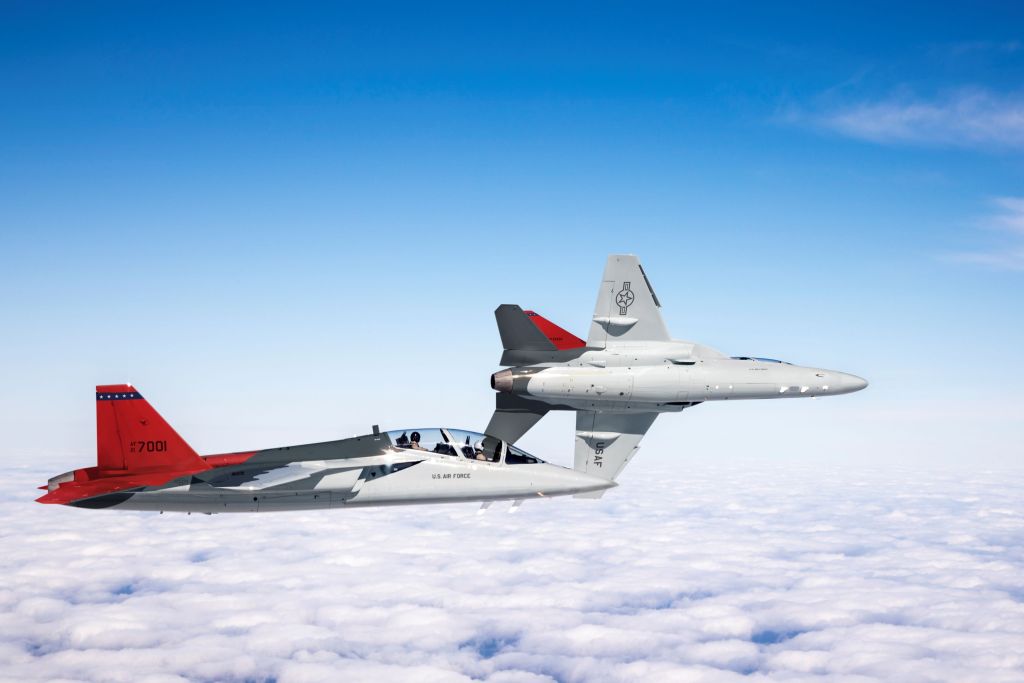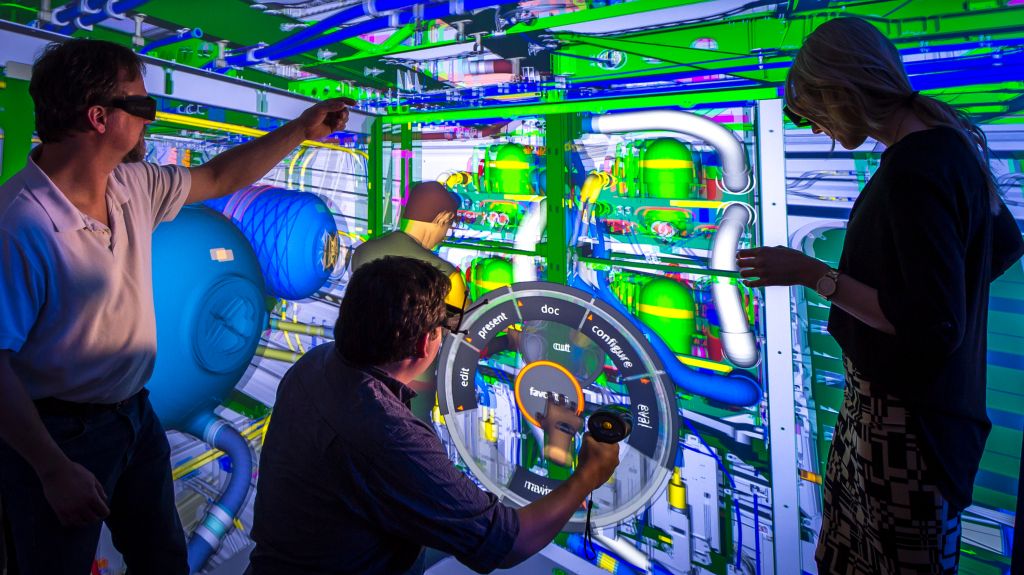It’s all taking shape

Bill Osborne, senior vice-president of Total Quality and Operations of Boeing Defence, Space & Security (BDS) reveals how the company is helping to shape the future of manufacturing.
As the aerospace industry lays the groundwork for increasingly digitised and advanced manufacturing operations, one of the best examples of Boeing’s journey toward Industry 4.0 can be found in England.
There, in South Yorkshire, our £40 million Boeing Sheffield facility produces high-tech actuation system components for 737 and 767 aircraft. Boeing Sheffield, which is our first factory in Europe, demonstrated the benefits of immersive reality the day its general manager took his first stroll down the factory floor.

As I look over every inch of the 6,200m2 facility, scanning and scrutinising every beam, panel, toolkit and machine, I view this new world not behind safety glasses, but with the aid of oversized goggles in a virtual reality headset and a joystick.
Boeing Sheffield opened in 2018 and was designed in a virtual reality model – a progression from the ‘paper doll’ miniatures and scale models Boeing has relied on to design a factory’s layout. This approach aided in the manufacturing layout and ergonomics, and revealed conflicts in the design that could be resolved early on, without costly rework, such as when a machine was positioned too close to safety features. This virtual reality model continues to serve a useful function today by running scenarios and simulations on how to further optimise the production system.
Add to that other advanced manufacturing techniques we implemented or are developing in Sheffield – a tooling application that measures consumption of tools and orders just-in-time replacements, sensors that detect when barrels of coolant and oils need to be ordered before supplies get too low, and a built-in, 10Gbit network – and it is clear the facility is a model that will help shape our approach when we design and build our next facilities worldwide.
Technology has had profound impacts on society. But the promises of technology revolutionising manufacturing and creating digital factories has only materialised in limited instances, and it has not yet been scaled for widespread adoption.

As Boeing and other aerospace manufacturers continue to recover from the pandemic economy, the effects of supply chain disruption, inflation and other external shocks, they will need to leverage technology to reduce tedious manual tasks and usher in new advanced techniques, processes, tooling and systems to remain competitive in the marketplace.
At Boeing, we’re investing in the future by developing this technology in four key areas – the digital thread, Smart Factory, human-robotics collaboration and quality processes – to enable breakthrough transformations across the production system.
The digital thread
We are working to connect data to make informed decisions across the product lifecycle. Having digital models and data of our products and systems, from a single aircraft to the factory that produces it, enables connectivity for data-driven decision making, from design and production to manufacturing and services.
We are also reimagining how work can be achieved by breaking down data silos across our enterprise to create a digital thread with consistent lines of understanding and sharing among engineers, designers and production teams. This lowers development costs, reduces barriers to entry via digital prototyping, identifies and solves problems quickly, and shortens production timelines.
For example, the Boeing T-7A Red Hawk advanced trainer is among the U.S. Air Force’s first aircraft, weapons, satellites and assets to be designed and built along a digital thread, embracing advanced manufacturing techniques to improve quality and enhance performance. Using model-based engineering and 3D design tools, the T-7A represents an aircraft with a 75% increase in first-time quality, an 80% reduction in assembly hours and a process that cut software development time in half. Thanks to these advanced techniques, the aircraft moved from firm design to first flight in just three years.
Similarly, a digital thread supports the Boeing technicians and mechanics in St. Louis, Missouri, building the MQ-25 Stingray, the U.S. Navy’s unmanned aerial refueler. There, teams are enabled with tablets and monitors to access 3D, model-based work instructions to assist in the assembly.
A factory connection
To enable a digital thread, a factory needs to be connected and transmitting live data to a digital model. It needs to have devices, machinery and production systems that are talking to each other, and constantly collecting and sharing data. This is the Smart Factory vision, and at Boeing we are on a journey to enable real-time data for situational awareness, improved insight, and rapid response to issues.
A 3D viewing model that shows product positions within the production system is one example of a Smart Factory, such as digital renderings of the commercial aircraft at our factories and delivery centres. Under this model, aircraft positions and technical performance data is published transparently throughout the enterprise, allowing programme executives, managers and support teams to monitor work performance and ensure jobs are being completed at each position before moving on to the next position on the manufacturing line.
![The U.S. Navy’s MQ-25 Stingray unmanned aerial refueler [MQ25]](/uploads/amm/articles/2022/06/21/40048/16558070437288.jpg)
In Sheffield, our Smart Factory capabilities can track the status of the machines building actuation components. This capability, called machine performance analysis, allows for live data analysis while the machines are running to monitor performance and maintenance needs.
Boeing is also deploying Smart Factory technologies around the company to help improve the way mechanics and other teams on the factory floor do their jobs and ensure they have the proper tools and parts. In some areas, we employ RFID to track equipment, tools and kits without human intervention at our factories.
One example is in tracking integrated kits, which are transported in automated carts and contain parts, tools, fasteners, and other consumables that mechanics need for their jobs. This reduces time spent looking for tools or parts, preventing schedule delays and increased costs and helping to reduce foreign object debris.
On our Boeing 737 and 787 programmes, we set up portals and zones within our factories so that when an integrated kit with RFID passes through a zone, an automated registry of its movement is created. This eliminates the need for someone to manually scan barcodes on each integrated kit.
We also continue to employ other sensors at other factories such as those that monitor for variations in temperature, smoke, humidity, particle count, vibration and noise. Our Industrial Internet of Things (IIoT) approach to building a connected factory is to standardise how various sensors are connected and collect their data in a common data platform, which enables analytics over larger data sets. The IIoT platform is foundational to unlocking new frontiers of improvement in safety and quality.
Technology collaboration
Technology is also enhancing the human experience in our factories through human-robotics collaboration. To enhance workplace safety, Boeing is rolling out exoskeleton personal protective equipment to lessen the pressure mechanics bear as they work repetitive jobs at chest level and above, such as sanding, sealing and painting our commercial aircraft.

We are also beginning to harness the power of augmented reality. A few years ago, we embarked on a project to simplify the process for electricians installing 120 miles of electrical wiring on the KC-46 Pegasus tanker.
Two-dimension drawings, sometimes measuring 6m long, can be complex and may require an electrician to spend extended time off the aircraft interpreting the drawings before installing the wiring.
The pilot project saw a team of developers come up with new, more intuitive ways of using advanced visualisation products to provide mechanics and technicians with real-time, hands-free, interactive 3D diagrams.
Using mixed reality smart-glasses, electricians were able to see the 3D wiring diagrams while they were on the aircraft for installation, resulting in an estimated 30% reduction in installation time.
Since then, a team of Boeing developers based in the US and in South Korea have developed the company’s software platform for augmented reality in the factory called the Boeing Augmented Reality Kit, or BARK, for wiring on other aircraft platforms, as well as to assist in the installation of brackets, fasteners, exterior paint decals and more.
That feel of quality
Finally, advanced manufacturing technologies can help us improve the quality of our work and our products. We are leveraging various technologies to improve Boeing’s Quality Management System (QMS) and advance our quality planning, inspection and non-conformance management processes.
Digital tools are enabling Boeing’s Advanced Product Quality Planning (APQP), a proactive, disciplined process geared toward identifying and mitigating risks in the production system and process design. For example, we envision our model-based systems engineering tool set will leverage real-time ‘smart data’ on all elements of the design process to relay changes and assess impacts dynamically. The tool can store APQP artifacts and build digital libraries, allowing pieces or entire models to be re-used for new projects.
APQP also helps teams implement process monitoring and data collecting, and can identify inconsistencies using Statistical Process Control (SPC) to proactively identify issues in real-time before parts or processes become non-conforming. This data generates learnings that can then be leveraged by AI tools that mine for additional improvements over time.
In this way, the emergence of the digital thread has made it a necessity to connect everything digitally, map processes and identify inconsistencies to ensure the thread is never broken.
Mixed-reality, holographic smart-glasses, meanwhile offer the potential to greatly reduce time and increase the accuracy of generating non-conformance reports. Quality inspectors manually record non-conformance issues. Using a Microsoft HoloLens headset, an inspector could instantly record the part number, exact location, inspection number, cost codes, and also take a photo of the issue. In the future, this technology may help cut the amount of time it takes to produce a nonconformance report by 50%, while improving quality.
In the future, cameras, sensors and holographic glasses may also be used to assist the verification process and work alongside quality inspectors to help identify if work has been done correctly. While it will take time for AI and object recognition systems to mature to the point required to do this, it offers great potential to improve existing processes and deliver enhanced quality.
Many other technologies that promise to improve safety, quality and production will take time as well to mature, including those to help us deliver on our goals of maintaining a net-zero future for Boeing operations through conservation and renewable energy.
Our commitment, however, is sound. At Boeing, we are embracing and investing in digital innovation and advanced manufacturing techniques to strengthen our production system, deliver on our commitment to quality and safety and harness productivity enhancements. When we mature these technologies and deploy them, these advances offer the potential to power a new era of growth and innovation for our company and the entire aerospace industry.













